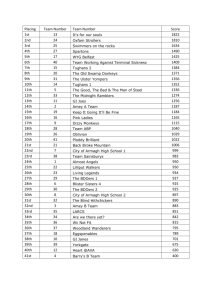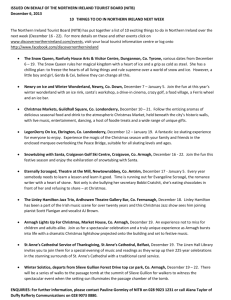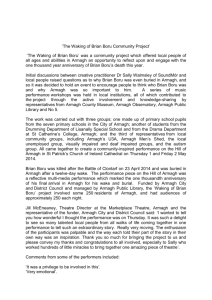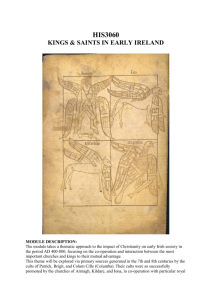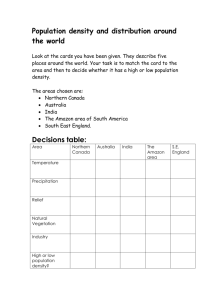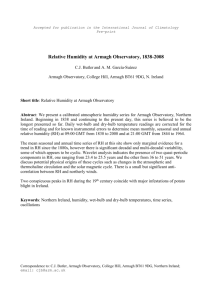Trends and Cycles in Long Irish Meteorological Series
advertisement
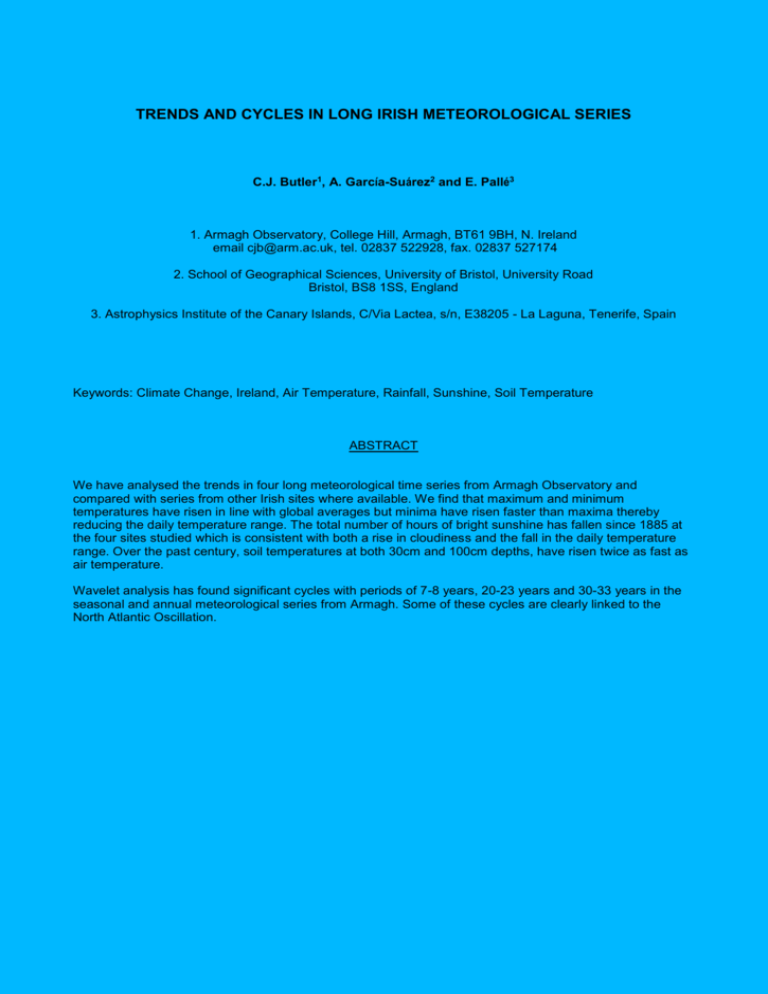
TRENDS AND CYCLES IN LONG IRISH METEOROLOGICAL SERIES C.J. Butler1, A. García-Suárez2 and E. Pallé3 1. Armagh Observatory, College Hill, Armagh, BT61 9BH, N. Ireland email cjb@arm.ac.uk, tel. 02837 522928, fax. 02837 527174 2. School of Geographical Sciences, University of Bristol, University Road Bristol, BS8 1SS, England 3. Astrophysics Institute of the Canary Islands, C/Via Lactea, s/n, E38205 - La Laguna, Tenerife, Spain Keywords: Climate Change, Ireland, Air Temperature, Rainfall, Sunshine, Soil Temperature ABSTRACT We have analysed the trends in four long meteorological time series from Armagh Observatory and compared with series from other Irish sites where available. We find that maximum and minimum temperatures have risen in line with global averages but minima have risen faster than maxima thereby reducing the daily temperature range. The total number of hours of bright sunshine has fallen since 1885 at the four sites studied which is consistent with both a rise in cloudiness and the fall in the daily temperature range. Over the past century, soil temperatures at both 30cm and 100cm depths, have risen twice as fast as air temperature. Wavelet analysis has found significant cycles with periods of 7-8 years, 20-23 years and 30-33 years in the seasonal and annual meteorological series from Armagh. Some of these cycles are clearly linked to the North Atlantic Oscillation. INTRODUCTION In the ongoing discussion of climate change, there is a need to identify trends and recurrent behaviour in long meterological series in order to develop a more comprehensive understanding of the processes involved. It is evident, from the outset, that standard procedures and techniques for observation and calibration of the basic climate data are required. World-wide, standard methods of measuring and recording meteorological data, were implemented during the second half of the 19th and first half of the 20th centuries. In Europe, these developments occurred somewhat earlier and we find series of basic meteorological data such as rainfall, pressure and temperature stretching well back into the 18th century. Frequently however, the instruments, used, their exposure and location have changed over the years with the result that the longest series are often composite, drawn together from several sites with a variety of instruments employed. In Ireland, regular observations of meteorological data were undertaken initially by scientific institutions established in the late 18th century and also by landlords with a scientific interest. Subsequently, some private meteorological stations on country estates, such as at Birr and Markree, have been absorbed into the official network. The most extended of the Irish series are from Armagh Observatory which, starting in 1796, now provide some of the longest from any single site in these islands. With funding from the Irish Soldiers and Sailor's Trust and the Heritage Lottery Fund, the large amount of manuscript meteorological material at Armagh has been converted to machine readable form and carefully calibrated and standardised. These data, together with that for some other Irish sites which have been kindly provided by Met Éireann, are the subject of this paper. DATA AND METHODS DATA Air Temperature There are three extensive and independent air temperature series for Armagh Observatory, namely: Series I (1796-1882), based on twice-daily morning and evening readings from a north wall screen, Series II (1844present) daily maximum and minimum temperatures, and Series III (1844-1965) twice daily readings from the dry bulb of the hygrometer (see Butler et al. 2005a; 2005b; 2005c). In Figure 1 we show the mean annual temperature for each of the three independent temperature series over the period 1796-2002. All of these data have been corrected for instrumental error, the time of observation if necessary, and exposure. Rainfall Daily readings from a variety of rain gauges have been made at Armagh Observatory since 1836, often with more than one gauge in operation at any one time. The overlaps have made it possible to compute conversion factors for the different gauges and to calibrate for sensitivity and exposure. Daily, monthly and seasonal rainfall data are given by García-Suárez et al. (2002). Earlier papers which reported Armagh precipitation data were published by Grew (1951) and Butler et al. (1998). Sunshine The daily total number of hours of bright sunshine have been recorded at Armagh since 1880 with a Campbell-Stokes Sunshine Recorder (Pallé and Butler 2001, Butler et al. 2005d). Data for the early years are sporadic and the annual and seasonal means are unreliable prior to 1885. The hours of bright sunshine for three stations in the Republic of Ireland which began at about the same time as Armagh, namely Birr, Co Offaly, Valentia, Co Kerry and the Phoenix Park, Dublin were kindly provided by Met Éireann. None of these data have been corrected for possible horizon changes due to tree growth or felling. Soil Temperatures The soil temperature series started at Armagh in 1904 and includes observations at 30cm and 100cm depths (previously 1 foot and 4 foot). Corrections have been made for the move from Imperial to Metric depths and for changes in the location of the instruments (García-Suárez et al. 2005, García-Suárez and Butler, 2006). STATISTICAL METHODS We have used two statistical packages in this work. For simple regression analysis we have used INSTAT developed by the University of Reading Statistical Services Centre and for cyclic analysis we have used the Torrence and Compo (1998) Wavelets package incorporated in IDL (Interactive Data Language). RESULTS TRENDS IN THE METEOROLOGICAL SERIES We have computed simple regression lines for the seasonal and annual meteorological series mentioned above. The slopes of the regression lines, their standard errors and the Pearson Correlation Coefficient between the data and the year of measurement are given in Table 1. We note the following trends in the data: Maximum, minimum and mean temperatures and daily temperature range In all seasons, the slope of the regression lines of maximum, minimum and mean air temperature with year are positive, with slopes steepest in autumn and lowest in winter. These are consistent with the well established warming that has occurred worldwide over the past century. However, we note that minimum temperatures are rising faster than maximum temperatures, leading to a decrease in the daily temperature range. Though there are some seasonal differences, similar trends were found by Sweeney et al. (2002); McElwain and Sweeney (2003); Folland et al. (2001). Increasing cloudiness and/or an enhanced greenhouse warming could be responsible. In Figure 2, we show the annual mean maximum, mean minimum, mean of maximum and minimum and daily temperature range from Series II (Butler et al. 2005b). There is evidence of non-linearity in the temperature variation in all seasons, with temperatures above the mean trend in the mid-19th century, the mid-20th century and at the end of the 20th century and below the trend at the end of the 19th century and in the 1970s and 1980s. These deviations from linearity closely parallel similar features in the Northern Hemisphere Mean Temperature of Jones et al. (1986). Note that the period 1880-1900 was exceptionally cold and therefore may not provide the most suitable baseline against which to compare temperatures in the following century. Rainfall In Figure 3, we show the total annual, winter and summer rainfall since 1838. Here and in Table 1 we see that there has been a significant increase in rainfall at Armagh in winter and spring since 1838, a marginal increase in autumn, and a significant decrease in summer. Annual rainfall has fallen since 1970, mostly due to the fall in summer. Sunshine There are significant negative trends in sunshine hours in spring, summer and autumn over the past century. In winter, which contributes only a small amount to the annual total, the trend is effectively flat. The fall in sunshine hours is believed to be due to increasing cloudiness and is clearly seen, not only at Armagh, but in data from Valentia, Birr and the Phoenix Park (Pallé and Butler, 2001). In Figure 4, we show the annual total number of sunshine hours recorded at these four Irish stations. The percentage drop varies from around 10% at Armagh to 20% in Valentia. Increases in cloudiness have been seen world-wide over recent decades (so-called global dimming) and have sometimes been ascribed to aircraft contrails and/or atmospheric pollution (see Stanhill, 2005). However, the fact that the decline in sunshine hours is steepest in Valentia where the atmosphere is least polluted would imply that in Ireland pollution is not the principal cause. Soil temperatures In Figure 5 we show the annual mean soil temperatures at 30cm and 100cm depths at Armagh. The trends in soil temperature since 1904 in Armagh are positive and clearly significant in all seasons at both 30cm and 100cm. García-Suárez and Butler (2006) found this to be true also for soil temperatures measured at Birr and Valentia. They found the seasonal dependence of the slope of the regression lines different in different parts of Ireland with the rise in temperature steepest in summer in Armagh and Birr and steepest in winter in Valentia. The annual trend varies from 0.13 degs C per decade at both 30cm and 100cm at Armagh to 0.19 degs C per decade at 100cm at Birr. It is important to note that soil temperatures at both 30cm and 100cm in Armagh have over the past century, increased about twice as fast as air temperature over the same period. This is particularly evident in spring, summer and autumn. Whilst soil temperatures in winter closely parallel air temperature, in other seasons they are also affected by rainfall. The dependence is complicated but, in general, increased precipitation leads to increased evaporation and a fall in soil temperature. Thus the decrease in summer rainfall since the 1970s may be partly responsible for the exceptional increase in soil temperature in this season later in the century as compared to earlier when summer rainfall was higher. CYCLES IN THE METEOROLOGICAL SERIES Over the past decade there has been increasing realisation of the importance of oscillatory pressure configurations in the Earth's global weather system. The Pacific Oscillation which gives rise to El Niño and La Niña has been known for over a century and similar oscillations in the north Atlantic can influence the weather in this region. It seems likely that these two oscillatory pressure regimes, namely the Southern Oscillation and the North Atlantic Oscillation are linked through an, as yet, not clearly understood teleconnection. The existence of a possible 7-year cycle in Irish climate was noted by the Revd. Henry Kingsmill in the 19th century. Such a periodicity was subsequently confirmed in some seasonal rainfall and temperature data from Armagh (Butler et al. 1998; 2005a). Often such cycles come and go, lasting only for a few decades at each appearance. For this reason, they are more clearly seen in wavelet analysis than in the Fourier power spectrum. Wavelets are able to pick up oscillations that last for a relatively short time and change their phase between one appearance and the next. Here we take another look at the possible cycles present in the Armagh meteorological series, examining not only rainfall and temperature but also sunshine and soil temperatures. In Table 2 we give the periodicities that are statistically significant at the 95% level in the annual and seasonal meteorological series from Armagh derived from the wavelet analysis. Below, we give the dominant periodicities from similar analyses of the Southern Oscillation (SOI) and the North Atlantic Oscillation (NAO) Indices. We note the common appearance of cycles in the range 7-8 years in both the meteorological series and the two global oscillations. In addition cycles with periods in the range 20-25 years and 30-33 years are common. Graphical illustrations from the wavelet analysis are shown for three example meteorological series in Figure 6 and the NAO and SOI in Figure 7. DISCUSSION Our survey of the trends in the four meteorological parameters: air temperature, rainfall, sunshine and soil temperature in Ireland has thrown up several expected and several unexpected results. Firstly, we find the trends in air temperature to be broadly consistent with those found in the Northern Hemisphere generally with positive trends in both maximum and minimum temperatures in all seasons. As for some other temperature series from Europe and elsewhere, there has been a gradual fall in the difference between mean maximum and minimum, i.e. the daily temperature range, over this period. The reason for this is uncertain but one factor may well be increasing cloudiness. The negative trends in sunshine, seen at the four stations in Ireland with records since the 1880s, are consistent with a decrease in daily temperature range, particularly if night-time cloudiness also increased. The rather strong rise in soil temperatures, twice that in air temperature, was unexpected and at present remains unexplained. A full explanation would require a detailed physical model of the radiative and conductive heating of the surface and transmission and storage of heat within the soil. This should now be possible with the calibrated meteorological series available for Armagh but is beyond the scope of this paper. The fall in Summer precipitation since the 1970s may explain part of the unexpectedly large positive trend in soil temperatures. However, regardless of the physical explanation, because soil temperatures are rising so quickly, the implications for soil evaporation, forestry and agriculture need to be explored. Wavelet analysis has shown that some of the same periodicities seen previously in rainfall and temperature are also present in sunshine and soil temperature for Armagh. The 6-8 year period, which is clearly seen in at least one season in all four meteorological series, is most likely associated with a similar periodicity in the North Atlantic Oscillation. However, it is evident from a comparison of Figures 6 and 7, that the periodicities are often more clearly seen in the wavelet plots for Armagh meteorological data than in those for the NAO and SOI where they form a broad spectrum of periodicities rather than a sharply defined peak. The implication could be drawn that the NAO, rather than controlling the meteorological series directly, is itself controlled by a common forcing mechanism. The physical nature of the driving force behind these oscillations remains unclear, however the fact that one of them occurs near 22 years, the period of the solar magnetic (Hale) cycle, suggests that, in this case at least, solar activity may be involved. Whilst these periodicities come and go, once the driving mechanism is more clearly understood, it may eventually be possible to use them in making long term estimates of future conditions, such as total summer rainfall. In conclusion, we point to the good correlation that has been found previously between conditions in Ireland and the wider Northern Hemisphere. For instance, decadal Armagh mean temperatures and the Northern Hemisphere mean temperature of Jones et al. (2006) for the period 1856-2005, have a correlation coefficient of 0.88. Likewise, it has been shown by Pallé and Butler (2001) that cloud cover over Ireland has a very similar behaviour with time to that over the North Atlantic and indeed further afield. Thus, long meteorological time series from Ireland are not just of local significance but have added value as proxies for the wider North Atlantic area. ACKNOWLEDGEMENTS We thank the Heritage Lottery Fund and the Irish Soldiers and Sailors Land Trust for financial support. Research at Armagh Observatory is grant-aided by the Department of Culture, Arts and Leisure for Northern Ireland. REFERENCES Butler, C.J. Coughlin, A.D.S. and Fee, D.T. 1998, Precipitation at Armagh Observatory 1838-1997. Biology and Environment: Proc. Royal Irish Academy, 98B, 123-140. Butler, C.J., García-Suárez, A.M., Coughlin, A.D.S. and Morrell, C. 2005a, Air temperatures at Armagh Observatory, Northern Ireland, from 1796 to 2002. Int. J. Climatol. 25, 1055-1079. Butler, C.J., García-Suárez, A.M., Coughlin, A.D.S. and Cardwell, D. 2005b, Daily, mean monthly, seasonal and annual maximum and minimum temperatures, 1844-2004. Meteorological Data recorded at Armagh Observatory: 2, Armagh Observatory Climate Series. Butler, C.J., Coughlin, A.D.S., Johnston, D.J., Cardwell, D. and Morrell. C. 2005c Daily, mean monthly, seasonal and annual air temperatures from Series I (1796-1882), including the Dunsink Patch (1825-1833) and Series III (1844-1964). Meteorological Data recorded at Armagh Observatory: 6, Armagh Observatory Climate Series. Butler, C.J., Emerson, M., García-Suárez, A.M., Pallé, E. and Kelly, S.T. 2005d Daily, monthly, seasonal and annual hours of bright sunshine, 1880-2004. Meteorological data recorded at Armagh Observatory: 10, Armagh Observatory Climate Series. Folland, C.K., Karl, T.R et al. 2001, Observed Climate Variability and Change. Climate Change 2001: The Scientific Basis, IPCC Report, WMO. García-Suárez, A.M., Butler, C.J., Cardwell, D., Coughlin, A.D.S., Donnelly, A., Fee, D.T., Hickey, K.R., Morrow, B. and Taylor, T. 2002, Daily, monthly and annual rainfall 1838-2001. Meteorological Data recorded at Armagh Observatory: 1. Armagh Observatory Climate Series. García-Suárez, A.M., Butler, C.J. and Morrow, B. 2005. Daily, mean monthly, seasonal and annual soil temperatures, 1904-2002. Meteorological data recorded at Armagh Observatory, 4, Armagh Observatory Climate Series. García-Suárez, A.M., Butler, C.J. 2006. Soil temperatures at Armagh Observatory, Northern Ireland from 1904 to 2002. Int. J. Climatol. 26, 1075-1089. Grew, S. 1951. Meteorology at Armagh Observatory: general notes and a study of rainfall. Irish Astron. J. 1. 230-237. Jones, P.D., Raper, S.C.B., Bradley, R.S., Diaz, H.F., Kelly, P.M. and Wigley, T.M.L. 1986. Northern Hemisphere surface air temperature variations, 1851-1984. J. Clim. and Applied Met. 25, 161-179. Jones, P.D., Osborn, T.J., Briffa, K.R. and Parker, D.E. 2006. Northern Hemisphere monthly and annual temperature anomalies 1856-2005. http://cdiac.ornl.gov McElwain, L. and Sweeney, J., 2003. Climate change in Ireland - recent trends in temperature and precipitation. Irish Geography 36, 97-111. Pallé, E. and Butler, C.J. 2001. Sunshine records from Ireland: Cloud factors and possible links to solar activity and cosmic rays. Int. J. Climatol. 21, 709-729. Stanhill, G. (2005), “Global dimming: A new aspect of climate change”, Weather, 60: 11-14. Sweeney, J., Donnelly, A., McElwain, L. and Jones, M., 2002. Climate change - indicators for Ireland. ERTDI Report Series No 2, Environmental Protection Agency, Ireland. Torrence, C. and Compo, G.P. 1998. A practical guide to Wavelet Analysis. Bull. Am. Met. Soc. 79, 61-78. Table 1. The slopes (a) of the regression lines, their standard errors (SE) and the Pearson Correlation Coefficient (R) for the Armagh meteorological series in different seasons. Units for the values of a and SE are: C yr-1 for temperature; mm yr-1 for rainfall and hrs yr-1 for sunshine. Table 1 is in a separate Excel file: table-1.xls Table 2. Cycles identified by Wavelet Analysis in the meteorological series for Armagh Observatory and in the Southern Oscillation and the North Atlantic Oscillation Indices. The periods are significant at the 95% probability level and are in units of years. Met. Variable Duration Annual J-D Air Temperature 1796-2002 22, 8 Rainfall 1838-2001 Sunshine 1885-2002 7 Soil Temp 100cm 1904-2004 11, ~30 Soil Temp. 30cm 1904-2004 Winter DJF 8 20 22 Spring MAM 18-20 22 23 16 8 NAO SOI 8 6 20, 7 4, 6 1820-2002 8 1850-2002 7 Summer JJA 23 7 7 13, 33 8 Autumn SON 30 13, 7, 30 7 7 FIGURE CAPTIONS Fig. 1. The three, independent, mean air temperature series from Armagh Observatory: Series I (continuous line), Series II (dashed-dotted line) and Series III (dotted line). The series shown with a dashed line is from Dunsink Observatory and covers a small gap from 1825-1833 in the Armagh series. See Butler et al. (2005a) for details. Fig. 2. The mean annual maximum (top), minimum (bottom) and mean temperature at Armagh and the mean annual daily temperature range (dotted line). Horizontal lines indicate mean values over the series. Fig. 3. Rainfall recorded at Armagh Observatory since 1838. Top panel – Annual, Centre panel – Summer, Bottom panel - Winter Fig. 4. The total annual hours of bright sunshine recorded with a Campbell Stokes Sunshine Recorder at the four Irish stations. Fig. 5. The mean annual soil temperature at 30cm and 100cm depth recorded at Armagh Observatory since 1904 Fig. 6. Examples of the graphical output from the wavelet analysis: Top – Summer rainfall; Middle – Summer sunshine; Bottom – Annual mean air temperature. The left panels give a contour plot of power in two dimensions, namely period (years) and time (year); and the right panels give the power against period for the entire series (the equivalent of a Power Spectrum of the Fourier Transform). The 95% level for the probability of occurrence by chance, is indicated by a dashed line (see Torrence and Compo, 1998 for details). Fig. 7. Wavelet plots for the annual North Atlantic Oscillation and the Southern Oscillation indices. Fig. 1. The three, independent, mean air temperature series from Armagh Observatory: Series I (blue), Series II (black) and Series III (red). The series shown with a green is from Dunsink Observatory and covers a small gap from 1825-1833 in the Armagh series. See Butler et al. (2005a) for details. Fig. 2. The mean annual maximum (top), minimum (bottom) and mean temperature at Armagh and the mean annual daily temperature range (dotted line). Horizontal lines indicate mean values over the series. Fig. 3. Rainfall recorded at Armagh Observatory since 1838. Top panel – Annual, Centre panel – Summer, Bottom panel - Winter Fig. 4. The total annual hours of bright sunshine recorded with a Campbell Stokes Sunshine Recorder at the four Irish stations. Fig. 5. The mean annual soil temperature at 30cm and 100cm depth recorded at Armagh Observatory since 1904 Fig. 6. Examples of the graphical output from the wavelet analysis: Top – Summer rainfall; Middle – Summer sunshine; Bottom – Annual mean air temperature. The left panels give a contour plot of power in two dimensions, namely period (years) and time (year); and the right panels give the power against period for the entire series (the equivalent of a Power Spectrum of the Fourier Transform). The 95% level for the probability of occurrence by chance, is indicated by a dashed line (see Torrence and Compo, 1998 for details). Fig. 7. Wavelet plots for the annual North Atlantic Oscillation and the Southern Oscillation indices.
